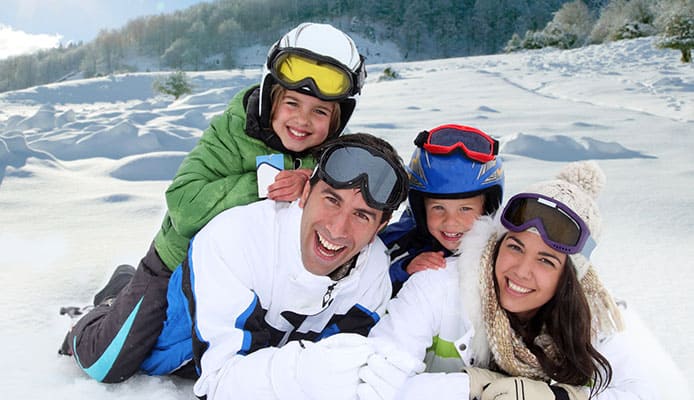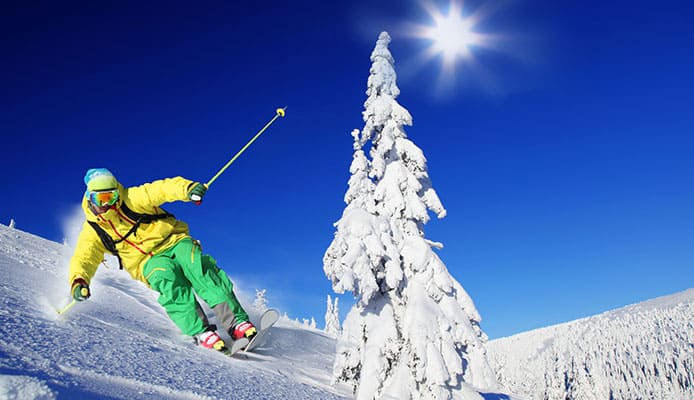
“Layering” is one of the most commonly used buzzwords in the skiing world. Surprisingly, not often will you come across a person who is willing to explain what it’s really about.
Well, that’s unfortunate because wrapping up is one of the surest ways to stay warm in the cold backcountry when on a ski trip or snowboarding adventure. Out on the snowy mountain slopes, atmospheric conditions are unpredictable, so it is important to go prepared with the right layers.
The most common layering system consists of a base layer, an insulating layer, and a waterproof/windproof layer. You can always add or peel off layers from the system in extreme conditions.
Layering can be an easy art to master. However, we have prepared a comprehensive guide on how to layer for skiing to help you understand the basics and do the perfect ski outfit.
The Base Layer
This is what goes next to your skin. The primary purpose of a base layer is to wick or draw off moisture from your body so you can stay warm. It goes without saying, therefore, that base layers should be made of wool or synthetic fibers.
Never use cotton in the base layer. In fact, never use cotton in any of your skin layers. You see, cotton will lose its insulating value as soon as it absorbs moisture. So if you sweat, you will get cold and sticky pretty fast.
Base layers come in various fabrics and forms. We recommend merino wool due to its heat-trapping properties and soft feel. Though merino fabrics are a little pricier than synthetics, they will feel more comfortable. And since they also regulate temperature much better, the same vest that warms you up when it’s cold will cool you down when it gets hot and you start to sweat up.
Most skiers and snowboarders will wear a long-sleeve shirt and long underwear as their base layers. Some will prefer capri-cut underwear that leaves the cuffs up and outside their ski or snowboard boots.
Base underwear will sit underneath your ski pants. We recommend underwear of a length that sits above your ankles so you won’t have excess material tucked under your socks or sitting inside your boots. A base pant too long might make it difficult for you to find a well-fitting boot, which could affect the choice of your ski or snowboard bindings.
Whatever base layer you choose for the day, make sure it fits snuggly and keeps you comfortable.
Middle Layer (Insulating Layer)
The mid-layer is usually meant for insulation. It is the layer that keeps you warm in cold temperatures. When layering for skiing, a middle layer is important because it seals in the heat produced by your body keeping you from freezing.
Midlayers are mostly used in extremely cold conditions. If you are skiing on a spring afternoon, you will probably only need an outer layer and a base layer.
A turtleneck, sweater, fleece jacket, or anything designed to keep you comfortable, warm, and ventilated without adding extra weight will work perfectly for mid-layers. Some skiers love to wear sweatshirts or vests as their midlayers.
If you are planning on cross country skiing, you may want to wear something light and packable as your base layer and such a combination will be found in a down jacket. However, you need to make sure that it fits comfortably over your base layer.
Also, if possible, look for a jacket that has water-resistant insulation, so that even if it gets wet, it won’t get dump and lose its warmth. Today, some ski clothing brands are using water-resistant materials in their mid-layers so that skiers can use them in various weather conditions without the need to add an outer shell.
It is always advisable to stash an insulating layer in your ski backpack even if the weather doesn’t feel too cold. It is difficult to predict atmospheric conditions and the only way to stay warm and safe is to go prepared.
Outer Layer
The outer layer has one purpose – to keep elements such as wind and rain at bay. That means the layer must be windproof and waterproof and most importantly, breathable. A good outer layer will keep moisture and cold air from getting in and at the same time allow the moisture produced by your sweat to escape.
When choosing an outer layer, you must get something that fits snuggly over your mid-layers. Also, make sure you are comfortable with its pocket layout because this is where you will put most of your stuff if you don’t want to bring a backpack.
Your ski jacket and ski pants will fall under this layer. Ski jackets fall under two categories; insulated jackets and shell jackets.
Insulated jackets will protect you from rain, snow, and wind and keep you warm throughout the day. A hardshell jacket or softshell jacket, on the other hand, will only shield you from the harsh weather but will not provide any insulation.
Ski pants come in insulated and shell styles too to keep you comfortable and warm. But the most ideal outer layer will be the one that is completely waterproof, windproof, seam-sealed, and insulated. Luckily, there are bountiful choices available on the market today. So no matter your budget, you will always find something that works for you when layering for skiing.
Other Essential Layers

Ski Socks
If you are looking for the best socks to wear on your ski trip, your best bet will be to buy ski socks. Sure, you may have up to ten pairs of hiking socks but even the thickest pair won’t cut it, simply because these are not designed with the insulation and other features required for skiing.
Socks designed for skiing will have seams and padding placed just in the right places. A good pair will be all you need to stay warm and comfy. If you get waterproof socks for skiing, even better, as these will make sure you stay warm and dry even if snow sneaks into your boots.
But do not wear more than a pair, as this can make it difficult for you to put on your ski boots, and even if you do actually wear the boots, your feet could feel very uncomfortable. However, we recommend buying two pairs or more, because each ski day will require a fresh pair.
Ski Gloves
Ski gloves are used to keep the hands warm and the fingers from going numb. There are two types of ski gloves – the traditional five-digit type and the mittens.
The five-digit model is the most popular among skiers and snowboarders because it offers optimal functionality and mobility. Gloves can have either long cuffs or short cuffs, which is an important factor to consider when making a purchase. Everybody has a personal preference for the length of the cuffs they want for their ski gloves.
Mittens are also another effective way of keeping your hands warm while skiing. They were once associated with snowboarders but in recent years, they have become more and more popular among snow hobbyists. Modern designs provide excellent warmth and a better grip to enable skiers to hold their ski poles without much effort.
Hat
When out in the snow, your head and ears need to stay warm too. But it is not easy to keep them this way all day and that’s why we recommend packing two hats.
You can carry a headband or lightweight hat for uphill travel and a warm non-sweaty beany for descents. Just like your base layers, your headwear should be made from merino wool to wick moisture and allow for ventilation. On a sunny day, even your hiking hat or a baseball cap will get the job done.
Ski Helmet
Well, a ski helmet can’t really be categorized as a layer, but it would be worth mentioning here because it too provides a good deal of warmth, not forgetting safety. When not skiing fast or aggressively, some skiers choose to forego helmets, but this is one of the things any serious skier doesn’t want to leave behind.
You may enter trees, ski steeper lines, or even hit your head on a rock and a helmet is the only thing that will keep your head safe. Moreover, today’s helmets are ridiculously lightweight and can seamlessly fit in a backpack, so you have no excuse not to bring one on your ski day.
You might also like: Top Ski Glove Liners
The Problem With Over-Layering
The more layers you have, the warmer you will be, right? Wrong!
Contrary to what many people believe, adding unnecessary layers will actually make you colder. If you sweat and trap moisture, you will quickly get wet and clammy. You will either feel very sticky or the moisture sucking your warmth out.
Wear only the amount of layers enough for your body and suitable for the weather. Overdoing it will just keep you less warm and less comfy. Wearing multiple winter coats, shirts, or vests is not layering!
The Do’s Of Layering
- DO air out your ski layers every day
- DO wear insulated mid-layer in extreme weather conditions
- DO wear dry clothes
- DO wear a highly waterproofed and breathable outer layer
- DO wear a thicker mid layer or base layer in colder temperatures
- DO make sure your layers fit you snuggly and allow you to move comfortably
The Don’ts Of Layering
- DO NOT wear more layers than necessary
- DO NOT wear wet ski clothes
- DO NOT wear cotton or fabrics that absorb sweat
- DO NOT wear normal clothes on a ski day
- DO NOT go skiing without a helmet
Globo Surf Overview
If prepared adequately, skiing can be a completely enjoyable and memorable moment. Dressing up in layers will keep you warm and cozy when hitting the slopes and help you adjust effectively to the changes in atmospheric conditions.
Now that you know how to layer for skiing properly, we believe you are now set for a good wrap up on your next ski or snowboarding trip. Just make sure the base layer manages moisture efficiently, the mid-layer provides good insulation, and the outer layer is waterproof and windproof to keep you from harsh elements.
More Snow Ski Gear Guides:
- DIN Calculator: Guide On How To Calculate DIN Setting For Ski Bindings
- How To Remove Ski Bindings
- Do You Really Need Ski Goggles
- Ski vs Snowboard Clothing Guide
- How To Choose Ski and Snowboard Goggles
- How To Size Ski Poles

